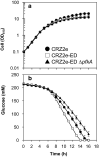Coexistence of the Entner-Doudoroff and Embden-Meyerhof-Parnas pathways enhances glucose consumption of ethanol-producing Corynebacterium glutamicum
- PMID: 33593398
- PMCID: PMC7888142
- DOI: 10.1186/s13068-021-01876-3
Coexistence of the Entner-Doudoroff and Embden-Meyerhof-Parnas pathways enhances glucose consumption of ethanol-producing Corynebacterium glutamicum
Abstract
Background: It is interesting to modify sugar metabolic pathways to improve the productivity of biocatalysts that convert sugars to value-added products. However, this attempt often fails due to the tight control of the sugar metabolic pathways. Recently, activation of the Entner-Doudoroff (ED) pathway in Escherichia coli has been shown to enhance glucose consumption, though the mechanism underlying this phenomenon is poorly understood. In the present study, we investigated the effect of a functional ED pathway in metabolically engineered Corynebacterium glutamicum that metabolizes glucose via the Embden-Meyerhof-Parnas (EMP) pathway to produce ethanol under oxygen deprivation. This study aims to provide further information on metabolic engineering strategies that allow the Entner-Doudoroff and Embden-Meyerhof-Parnas pathways to coexist.
Results: Three genes (zwf, edd, and eda) encoding glucose-6-phosphate dehydrogenase, 6-phosphogluconate dehydratase, and 2-keto-3-deoxy-6-phosphogluconate aldolase from Zymomonas mobilis were expressed in a genetically modified strain, C. glutamicum CRZ2e, which produces pyruvate decarboxylase and alcohol dehydrogenase from Z. mobilis. A 13C-labeling experiment using [1-13C] glucose indicated a distinctive 13C distribution of ethanol between the parental and the ED-introduced strains, which suggested an alteration of carbon flux as a consequence of ED pathway introduction. The ED-introduced strain, CRZ2e-ED, consumed glucose 1.5-fold faster than the parental strain. A pfkA deletion mutant of CRZ2e-ED (CRZ2e-EDΔpfkA) was also constructed to evaluate the effects of EMP pathway inactivation, which showed an almost identical rate of glucose consumption compared to that of the parental CRZ2e strain. The introduction of the ED pathway did not alter the intracellular NADH/NAD+ ratio, whereas it resulted in a slight increase in the ATP/ADP ratio. The recombinant strains with simultaneous overexpression of the genes for the EMP and ED pathways exhibited the highest ethanol productivity among all C. glutamicum strains ever constructed.
Conclusions: The increased sugar consumption observed in ED-introduced strains was not a consequence of cofactor balance alterations, but rather the crucial coexistence of two active glycolytic pathways for enhanced glucose consumption. Coexistence of the ED and EMP pathways is a good strategy for improving biocatalyst productivity even when NADPH supply is not a limiting factor for fermentation.
Keywords: Corynebacterium glutamicum; Entner–Doudoroff pathway; Glycolysis; Oxygen deprivation.
Conflict of interest statement
The authors declare that they have no competing interests.
Figures




Similar articles
-
Expression of Phosphofructokinase Is Not Sufficient to Enable Embden-Meyerhof-Parnas Glycolysis in Zymomonas mobilis ZM4.Front Microbiol. 2019 Sep 27;10:2270. doi: 10.3389/fmicb.2019.02270. eCollection 2019. Front Microbiol. 2019. PMID: 31611868 Free PMC article.
-
Fructose metabolism in Chromohalobacter salexigens: interplay between the Embden-Meyerhof-Parnas and Entner-Doudoroff pathways.Microb Cell Fact. 2019 Aug 13;18(1):134. doi: 10.1186/s12934-019-1178-x. Microb Cell Fact. 2019. PMID: 31409414 Free PMC article.
-
Co-production of hydrogen and ethanol from glucose in Escherichia coli by activation of pentose-phosphate pathway through deletion of phosphoglucose isomerase (pgi) and overexpression of glucose-6-phosphate dehydrogenase (zwf) and 6-phosphogluconate dehydrogenase (gnd).Biotechnol Biofuels. 2017 Mar 29;10:85. doi: 10.1186/s13068-017-0768-2. eCollection 2017. Biotechnol Biofuels. 2017. PMID: 28360941 Free PMC article.
-
Alternative carbohydrate pathways - enzymes, functions and engineering.Crit Rev Biotechnol. 2020 Nov;40(7):895-912. doi: 10.1080/07388551.2020.1785386. Epub 2020 Jul 13. Crit Rev Biotechnol. 2020. PMID: 32654530 Review.
-
Embden-Meyerhof-Parnas and Entner-Doudoroff pathways in Thermoproteus tenax: metabolic parallelism or specific adaptation?Biochem Soc Trans. 2004 Apr;32(Pt 2):303-4. doi: 10.1042/bst0320303. Biochem Soc Trans. 2004. PMID: 15046594 Review.
Cited by
-
Metabolic profiling and genetic tool development in the mucosal bacterium Selenomonas sputigena.Genes Genomics. 2025 Aug 20. doi: 10.1007/s13258-025-01668-1. Online ahead of print. Genes Genomics. 2025. PMID: 40835787
-
Exploitation of Hetero- and Phototrophic Metabolic Modules for Redox-Intensive Whole-Cell Biocatalysis.Front Bioeng Biotechnol. 2022 Apr 13;10:855715. doi: 10.3389/fbioe.2022.855715. eCollection 2022. Front Bioeng Biotechnol. 2022. PMID: 35497353 Free PMC article. Review.
-
Construct a synthetic Entner-Doudoroff pathway in Bacillus licheniformis for enhancing lichenysin production.World J Microbiol Biotechnol. 2023 Apr 24;39(7):168. doi: 10.1007/s11274-023-03619-y. World J Microbiol Biotechnol. 2023. PMID: 37088857
-
Tailoring Corynebacterium glutamicum for Sustainable Biomanufacturing: From Traditional to Cutting-Edge Technologies.Mol Biotechnol. 2025 Jun 10. doi: 10.1007/s12033-025-01447-z. Online ahead of print. Mol Biotechnol. 2025. PMID: 40493161 Review.
-
Deep Isolated Aquifer Brines Harbor Atypical Halophilic Microbial Communities in Quebec, Canada.Genes (Basel). 2023 Jul 26;14(8):1529. doi: 10.3390/genes14081529. Genes (Basel). 2023. PMID: 37628582 Free PMC article.
References
LinkOut - more resources
Full Text Sources
Other Literature Sources
Molecular Biology Databases
Research Materials

